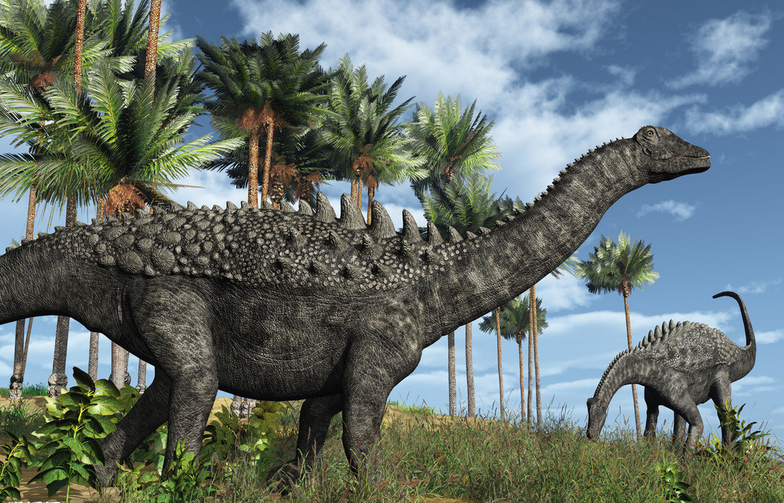(单词翻译:单击)
Although its teeth were formidable, the claws on their hands were just as important in a fight.
虽然它的牙齿是很强的武器,但它们的爪子在争斗中也极为重要。
They really look a lot like cat talons.
它们看上去极像猫的爪子。
They're pretty incredible and I suspect they were used in much the same way.
它们很不可思议,我猜它们的作用也差不多。
These were very, very sharp instruments of great pain.
这些非常锐利的武器能带来剧烈的疼痛。

But one thing set this dinosaur apart from all other meat eaters - the killing claw.
但恐龙的这种武器使之在所有的肉食恐龙中鹤立鸡群——它的猎杀爪。
With this claw on the foot, this was clearly a killing claw, but what was it doing? Going after the ankles of other dinosaurs?
脚上的这根爪子很明显是致命的利爪,但具体功能是什么呢?攻击其它恐龙的脚踝吗?
No. In order for it to have been useful, it had to be leaping around to slash and tear at its victims.
不是,要想能够发挥其能力,迅猛龙要跳到半空去撕扯猎物。
Well, the thing that really typifies Dromaeosaurs in general, the group to which Deinonychus belongs, is that they have this large raptorial claw on their foot.
恐爪龙属于驰龙类恐龙,它们最明显的共同特征就是它们脚上猛禽般的大型利爪。
And even the claw today, the bony part of the claw, is about four inches long or so.
即便到了现在,爪子的骨质部分长度也有十多厘米。
But in life it would have been covered with a sheaf like a fingernail that would of made the claw twice as large.
它活着时,这上面会有一层像指甲的鞘,使得爪子变成两倍大。
So it would have been a pretty spectacular weapon.
所以它是一种极为惊人的武器。
CAT scan research of their brain cavities conducted by Dr. Larry Witmer of Ohio University, concluded that members of the Raptor family had excellent vision.
俄亥俄大学拉瑞·维特莫博士对其颅腔进行CT扫描,得出的结论是迅猛龙一类,具有非常敏锐的视力。
What I was able to do was get my hands on a variety of fossil skull bones of Deinonychus and CAT scanned a variety of them to get a glimpse inside the head of Deinonychus.
我做的就是找到各种恐爪龙的头骨化石,并对它们进行CT扫描,以便能对其颅内有所了解。
When we look inside the brain cavity of Deinonychus what we see is an expansion of the visual centers.
当我们观察恐爪龙的颅腔内部时,我们看到了视觉中枢的膨大。
Centers that in more primitive dinosaurs, we didn't really see enlarged.
在更原始的恐龙颅腔里,我们看不到它的伸展。
That suggests to us that vision was a very important sensory modality in Deinonychus and Utah Raptor and these other Raptors.
这表明视觉能力对于恐爪龙、犹他伶盗龙和各种迅猛龙都是至关重要的。
It was clearly a major part of their hunting strategy.
这显然是它们猎杀策略的重要组成部分。
In fact, their vision was so good, experts had to consider if they had night vision.
事实上,它们的视力很敏锐,专家需要考虑它们有夜视能力。
They had a very large optic lobe of the brain, so there's no reason to think that they could not have hunted at night.
它们的脑里有一个很大的视叶,所以我们没有理由认为它们不能在夜间捕猎。
But it doesn't mean that they were restricted to that.
但也并不意味着它们仅限于此。
Having that incredible eyesight would not just be helpful at night, it would be an awesome asset anytime there is limited light.
其非凡的视力不仅有助于夜间活动,光线不足时也对它们非常有利。
During volcanic activity or storms, they would still have the ability to see when other creatures wouldn't have.
在火山爆发或风暴来临时,它们仍能看到其它动物看不见的东西。
Like a modern cat, Raptors relied on their large eyes to hunt in the dark.
像现今的猫科动物一样,迅猛龙靠大眼睛在夜间狩猎。
They were perfectly suited for night kills.
它们非常适合夜间猎杀。


